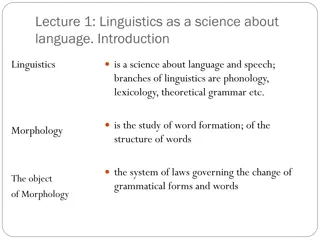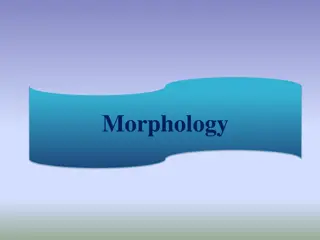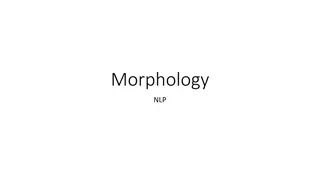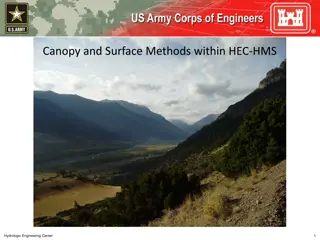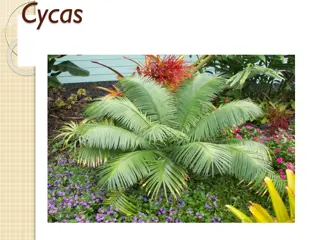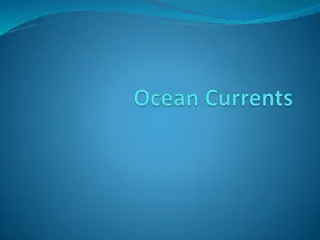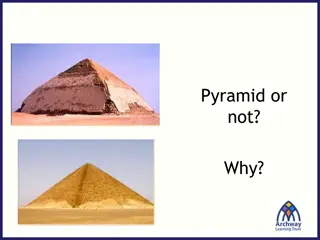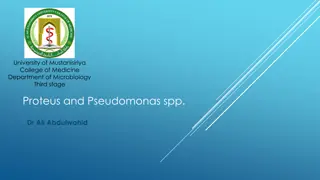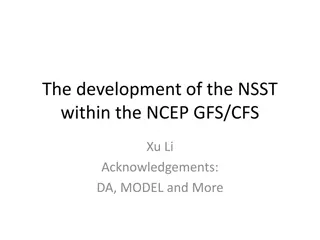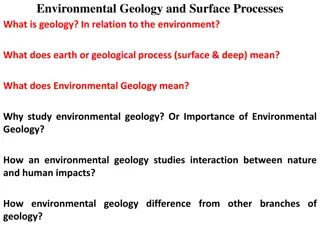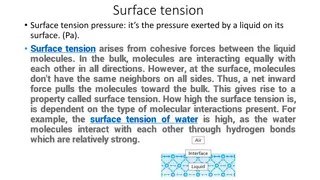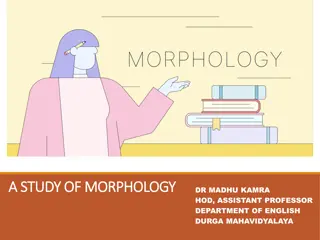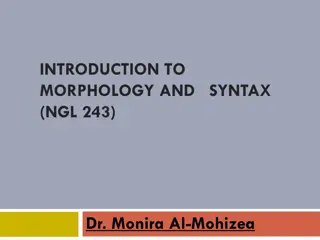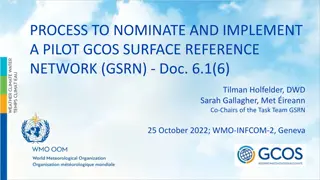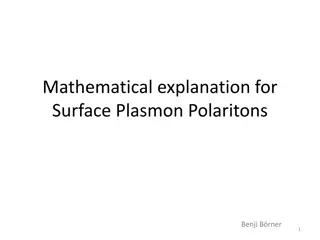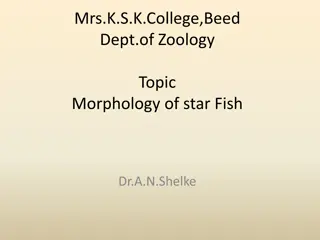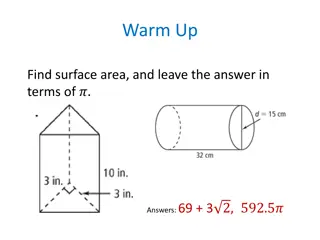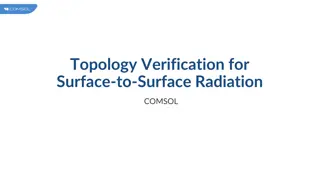Exploring Surface Tension and Wettability in Nature
Discover the fascinating world of surface tension and wettability through engaging experiments and observations, from water cohesion on a penny to the microscopic structures on lotus leaves. Delve into the role of cohesion and adhesion, surface wettability factors, and everyday applications of these
2 views • 17 slides
Understanding Surfaces and Interfacial Energy in Chemistry
Surfaces play a crucial role in free energy and dissolution processes, impacting surface tension and interfacial energy. Learn about the adsorption of molecules, surface excess properties, and the contributions of surface area and curvature to surface energy. Dive into concepts such as Laplace's equ
6 views • 71 slides
Understanding Alluvial Fans: Formation, Characteristics, and Morphology
Alluvial fans are cone-shaped landforms formed by streams carrying sediments from mountains onto plains. They are prominent in arid to semi-arid regions and vary in size from a few meters to over 150 kilometers. The different zones of an alluvial fan, including the fan apex and distal fan, display d
5 views • 9 slides
Linguistics: Exploring Language Structure and Morphology
Linguistics is the scientific study of language and speech, encompassing branches like phonology, lexicology, and morphology. This field delves into the levels of language structure, such as phonological, morphological, lexical, syntactic, semantical, pragmatical, and stylistical. Scholars began inv
8 views • 7 slides
DERIVATIONAL MORPHOLOGY. PREFIXATION.
Derivational morphology in the English language involves forming new words by adding affixes to a base, resulting in derivatives or derived words. Prefixation is a productive process, especially for verb and adjective formation. Prefixes can be classified based on their meanings, such as negative, p
6 views • 6 slides
Understanding English Morphology: The Study of Words and Meaning
English Morphology delves into the structure of words, exploring morphemes as the building blocks of linguistic meaning. From free morphemes like "certain" to bound morphemes like "-ly," the discipline uncovers how words are constructed and adapted grammatically. By examining the derivational and in
0 views • 49 slides
Understanding Morphology: Word Structure and Morphemes
Morphology, a branch of linguistics, focuses on word structure by examining morphemes, which are the smallest meaningful units of language. Morphemes can be free or bound, with bound morphemes modifying the meaning of free morphemes through affixes like prefixes and suffixes. Types of affixes includ
0 views • 14 slides
Understanding Morphology in Linguistics
Morphology is a branch of linguistics that explores the structure of words in different languages. It involves dissecting words into meaningful parts called morphemes, such as prefixes and suffixes, to study their grammatical functions. Various distinctions like free vs. bound morphemes and derivati
0 views • 25 slides
Topic 7 Morphology
Delve into the realm of morphology in linguistics, exploring the internal structure of words, how words transform based on grammatical roles, and the processes of word formation through inflectional and derivational morphology. Uncover the various morphological processes and delve into the significa
0 views • 22 slides
Understanding Morphology: The Study of Words and Morphemes
Morphology is the linguistic study of how words are formed and their relationships within a language, analyzing the structure of words, morphemes, prefixes, suffixes, and more. It enriches vocabulary knowledge and aids in understanding word formations.
0 views • 16 slides
Understanding Morphology: The Study of Word Formation
Morphology is the study of how words are formed from smaller units called morphemes. This involves analyzing the structure and meaning of morphemes, whether they are free or bound. By dissecting words like "untied," we can see how morphemes contribute to linguistic patterns and communication.
0 views • 4 slides
Understanding Canopy and Surface Methods in HEC-HMS
Explore the various canopy and surface methods utilized in HEC-HMS for managing water resources. Learn about canopy interception, evapotranspiration, common parameter values, and factors affecting losses. Delve into available methods, canopy storage values, and surface depression storage. Enhance yo
0 views • 12 slides
Based on the content provided, here is the information: "Stylistic Analysis & Morphology in Visual Presentation
Explore the connection between stylistic analysis and morphology in a visual context. Dive into the intricacies of form and style through a series of slides illustrating key concepts and examples.
0 views • 20 slides
Understanding Runoff in Surface Water Systems
Runoff, the flow of precipitation and other contributions in surface streams, plays a crucial role in watershed systems. It encompasses various sources such as surface runoff, interflow, and base flow. Surface runoff, which travels over the ground surface to channels, is influenced by factors like s
1 views • 27 slides
Understanding Cycas: A Detailed Look at the Morphology and Characteristics
Sixteen species of Cycas are distributed across tropical and sub-tropical regions, with India hosting six species. Cycas plants are evergreen and resemble palm trees, with unique root and stem structures. The plant body consists of an arborescent stem and distinctive leaf morphology. Cycas leaves ar
0 views • 26 slides
Understanding Ocean Currents and Effects
Ocean currents play a crucial role in the movement of water across the Earth's surface. Wind-driven surface currents, influenced by the Coriolis effect, move water horizontally and impact climate patterns worldwide. Major currents extend deep below the surface and can move rapidly, while rip current
0 views • 14 slides
Exploring Surface Area in Mathematics
Delve into the concept of surface area as an essential mathematical topic, understanding its significance in everyday life and its application in various 3D shapes. Learn how to calculate surface area for different space figures like prisms and pyramids through step-by-step methods. Engage with esse
6 views • 21 slides
Exploring Pyramid Geometry for Surface Area Calculations
Delve into the concept of surface area calculations for pyramids, ranging from identifying fake pyramids to determining the surface area of iconic structures like the Great Pyramid. Learn about the essential information needed, such as base length and slant height, to derive accurate measurements. D
0 views • 32 slides
Understanding Proteus Species: Morphology, Cultural Characteristics, and Antigenic Structure
Proteus species, specifically P. mirabilis and P. vulgaris, are important opportunistic pathogens in human infections. They exhibit unique characteristics such as swarming growth on agar, gram-negative coccobacilli morphology, and distinctive antigenic structures with O and H antigens. The swarming
1 views • 25 slides
Understanding Surface Tension in Physical Pharmacy Lab
Surface tension is a crucial concept in physical pharmacy lab dealing with gas-solid or gas-liquid interfaces. It refers to the force per unit length required to balance the inward pull on the surface. Interfacial tension, cohesive forces, and adhesive forces play significant roles in determining su
0 views • 16 slides
Understanding Near-Surface Sea Temperature Development in NCEP GFS/CFS
This informative piece delves into the evolution of Near-Surface Sea Temperature (NSST) within the NCEP GFS/CFS, discussing its significance in Numerical Weather Prediction (NWP) systems, the utilization of sea surface temperature (SST), and the T-profile near the sea surface. It covers the role of
0 views • 28 slides
Understanding Atmosphere-Ocean Coupling in Madden-Julian Oscillation
Atmosphere-ocean coupled processes in the Madden-Julian Oscillation (MJO) play a crucial role in intraseasonal oscillations. This paper review by Shao Yun-Chuan explores how the ocean's Sea Surface Temperature (SST) influences surface fluxes, MJO convection, and energy balance dynamics. It delves in
0 views • 17 slides
Understanding Environmental Geology and Surface Processes
Geology in relation to the environment involves studying Earth's geological processes, both surface and deep, and their impacts on nature and human activities. Environmental geology focuses on the interaction between humans and the Earth's near-surface environment, addressing hazards like erosion, f
0 views • 71 slides
Surface Ozone Seasonal Cycle Reversal Study in Northeastern United States Lower Manhattan
Study on the reversal of the surface ozone seasonal cycle over Northeastern United States Lower Manhattan, analyzing the impact of NOx and VOC emissions on Surface O3 levels. Research shows a 26% decrease in regional NOx emissions leading to changes in the seasonal cycle of surface ozone concentrati
0 views • 24 slides
Understanding Surface Tension in Physical Pharmacy Lab
Surface tension is a critical aspect in physical pharmacy lab experiments, involving the study of forces at gas-solid or gas-liquid interfaces. It is the force per unit length required to counterbalance the net inward pull on a surface. The concept extends to interfacial tension, cohesive and adhesi
0 views • 21 slides
Understanding Surface Tension: Properties, Measurement Methods, and Calculations
Surface tension is the pressure exerted by a liquid on its surface due to cohesive forces among molecules. The measurement methods include the liquid rise in a capillary tube technique, drop weight method, and bubble pressure method. The surface tension coefficient can be calculated using the equati
0 views • 12 slides
Understanding Bacterial Colony Morphology for Microbiology Analysis
Bacterial colonial morphology plays a crucial role in identifying bacteria and fungi. This exercise focuses on recognizing the cultural characteristics of bacteria on agar plates through colony morphology. Each colony represents a genetically similar group of microorganisms derived from a single cel
0 views • 6 slides
A Study of Morphology: Insights into Word Formation and Structure
Morphology, a field of linguistics originating from Greek words, delves into the study of word structure. It explores types of morphemes, branches of morphology, and processes like affixation and vowel change. The creation of new words and changes in existing ones through grammatical functions are a
0 views • 9 slides
Understanding Morphology and Syntax with Dr. Monira Al-Mohizea
Explore the fascinating realm of morphology and syntax in language with Dr. Monira Al-Mohizea's insightful guide. Learn about the internal structure of words, morphemes, and the aim of morphology to uncover subconscious knowledge. Delve into discussions on what constitutes a word and various definit
0 views • 19 slides
Exploring NLP: Morphology, Lexicon, and Morphological Examples
Delve into the world of Natural Language Processing (NLP) through an exploration of NLP Morphology and the Lexicon. Discover the intricacies of the Mental Lexicon, Derivational Morphology, and Inflectional Morphology. Uncover examples of Reduplication, Templatic morphology, Clitics, Portmanteau word
0 views • 13 slides
Understanding Surface Chemistry and Adsorption Phenomena
Surface chemistry is a crucial branch of chemistry that focuses on the chemical processes occurring at interfaces between different surfaces like solid-liquid, solid-gas, and liquid-gas. This field plays a significant role in various industries, including electronics. Adsorption, absorption, and sor
0 views • 15 slides
Understanding Surface Chemistry and Adsorption Phenomenon
Surface chemistry explores the interactions that occur at surfaces and interfaces, with adsorption being a key phenomenon. Adsorption involves the concentration of molecules on a surface, with adsorbents and adsorbates playing crucial roles. Desorption, the opposite process, removes adsorbed substan
1 views • 21 slides
Establishment of GCOS Surface Reference Network (GSRN) Pilot Phase
The establishment of the GCOS Surface Reference Network (GSRN) Pilot Phase aims to improve the accuracy, stability, and comparability of surface observations for Essential Climate Variables (ECVs). The GSRN will serve as the reference network for surface observations, providing data traceability and
0 views • 7 slides
Changes in Viscose Fabric Surface Morphology Due to Sunlight Exposure
This study explores the impact of sunlight exposure on the surface morphology of viscose fabrics. Direct exposure to sunlight for 120 days during summer showed significant changes in fiber surface depressions. The observed damage in mechanical properties correlated with alterations in surface morpho
0 views • 11 slides
Mathematical Insights into Surface Plasmon Polaritons
This mathematical explanation delves into the intricacies of surface plasmon polaritons, covering Maxwell's equations, wavenumbers, bulk and surface plasmon-polariton formulations, medium considerations, excitation conditions, losses, and matching examples with air, gold, and sapphire prisms. Detail
0 views • 13 slides
Morphology of Starfish at Mrs. K.S.K. College, Beed
Mrs. K.S.K. College in Beed, under the Department of Zoology, delves into the fascinating morphology of starfish. The external features of starfish, including its shape, size, and color variations, are explored. Specific focus is given to the radially symmetrical and pentamerous body structure of st
0 views • 14 slides
Satellite Applications in Estimating Earth's Surface Energy Budget
Satellites play a crucial role in estimating the Surface Energy Budget (SEB) by providing data on various components such as Surface Radiation Budget and Surface Turbulent Fluxes. The SEB includes factors like net radiation flux, sensible and latent heat fluxes, and subsurface heat transfer. Satelli
0 views • 38 slides
Understanding Morphology: Building Blocks of Language
Morphology is the study of the internal structure of words and how they are formed from morphemes, such as stems and affixes. By analyzing morphology, we can understand how words are created and related to each other, enabling us to generalize, obtain additional information, and handle new words eff
0 views • 49 slides
Geometry Concepts for Surface Area Calculations
Explore various geometric shapes such as pyramids and cones to calculate surface area. Learn the differences between prisms and pyramids, understand the importance of altitude and slant height in pyramids, and differentiate between lateral and surface areas. Practice finding lateral and surface area
0 views • 16 slides
Surface-to-Surface Radiation Verification and Boundary Detection in COMSOL
Explore the verification of surface-to-surface radiation setups in COMSOL, detecting incorrect radiation configurations with nonradiating boundaries. Learn how to identify and resolve nonradiating boundaries, ensuring accurate and effective radiation simulations. Discover the importance of selecting
0 views • 10 slides



